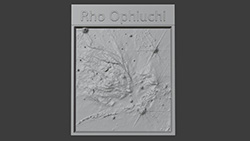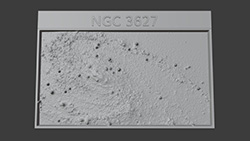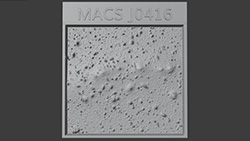CXC Home | Search | Help | Image Use Policy | Latest Images | Privacy | Accessibility | Glossary | Q&A
1
X-ray, Optical, & Infrared images of four objects.Credit:
Rho Ophiuchi: X-ray: NASA/CXC/MIT/C. Canizares; IR: NASA/ESA/CSA/STScI/K. Pontoppidan; Image Processing: NASA/ESA/STScI/Alyssa Pagan, NASA/CXC/SAO/L. Frattare and J. Major
M42 (Orion Nebula): X-ray: NASA/CXC/SAO/E. Feigelson; IR: NASA/ESA/CSA/STScI; Image Processing: NASA/CXC/SAO/L. Frattare and J. Major
NGC 3627: X-ray: NASA/CXC/SAO; Optical: NASA/ESO/STScI, ESO/WFI; Infrared: NASA/ESA/CSA/STScI/JWST; Image Processing: NASA/CXC/SAO/J. Major
MACS J0416.1-2403: X-ray: NASA/CXC/SAO/G. Ogrean et al.; Optical/Infrared: (Hubble) NASA/ESA/STScI; IR: (JWST) NASA/ESA/CSA/STScI/Jose M. Diego (IFCA), Jordan C. J. D'Silva (UWA), Anton M. Koekemoer (STScI), Jake Summers (ASU), Rogier Windhorst (ASU), Haojing Yan (University of Missouri)
These images show X-rays from NASA’s Chandra X-ray Observatory and infrared data from NASA’s James Webb Space Telescope. The objects are Rho Ophiuchi, a cloud complex with gas and stars of different ages and sizes; the Orion Nebula, one of the closest star formation regions to Earth; NGC 3627, a barred spiral galaxy that we see at a slight angle; and the galaxy cluster J0416.1-2403, a massive structure that contains thousands of galaxies and huge amounts of hot gas. In each image, various colors represent different wavelengths of light collected by the telescopes.
2
3D Printable Files: Rho Ophiuchi (3D Print Credit: NASA/CXC/A. Jubett, using software by Tactile Universe/N. Bonne & C. Krawczyk & Blender)
This tactile plate is a physical relief map based on the intensity of X-ray and Infrared data, depicting a cloud complex filled with gas, and dotted with stars. The murky cloud resembles a ghostly head in profile, swooping down from the upper left, trailing tendrils of hair. Cutting across the bottom edge and lower righthand corner of the plate is a long, narrow, string-like cloud which resembles the ember of a stick pulled from a fire. Several large stars dot the image. Many are surrounded by rings and diffraction spikes.
3D Printable Files: Orion Nebula/M42
(3D Print Credit: NASA/CXC/A. Jubett, using software by Tactile Universe/N. Bonne & C. Krawczyk & Blender)
(3D Print Credit: NASA/CXC/A. Jubett, using software by Tactile Universe/N. Bonne & C. Krawczyk & Blender)
This tactile plate is a physical relief map based on the intensity of X-ray and Infrared data, depicting the Orion Nebula, which blankets the entire image. Here, the young star nursery resembles a dense, stringy cloud, peppered with thousands of point-like stars. Layers of cloud around the edges of the plate, and a concentration of stars pushing out a bump at its distant core, help convey the depth of the nebula.
3D Printable Files: NGC 3627
(3D Print Credit: NASA/CXC/A. Jubett, using software by Tactile Universe/N. Bonne & C. Krawczyk & Blender)
(3D Print Credit: NASA/CXC/A. Jubett, using software by Tactile Universe/N. Bonne & C. Krawczyk & Blender)
This tactile plate is a physical relief map based on the intensity of X-ray, Optical and Infrared data, depicting a spiral galaxy known as NGC 3627. Here, the galaxy appears pitched at an oblique angle, tilted from our upper left down to our lower right. Much of its face is angled toward us, making its spiral arms easily identifiable. Several dots with raised rings speckle the galaxy. At the galaxy's core, where the spiral arms converge, a large bump identified by Chandra provides evidence of a supermassive black hole.
3D Printable Files: MACS J0416.1-2403
(3D Print Credit: NASA/CXC/A. Jubett, using software by Tactile Universe/N. Bonne & C. Krawczyk & Blender)
(3D Print Credit: NASA/CXC/A. Jubett, using software by Tactile Universe/N. Bonne & C. Krawczyk & Blender)
This tactile plate is a physical relief map based on the intensity of X-ray, Infrared, and optical data, depicting the distant galaxy cluster known as MACS J0416. Here, the vastness of space is packed with pointed dots and tiny raised shapes, each a distinct galaxy. Gently arched across the middle of the frame is a less prominent band; a reservoir of superheated gas detected by Chandra.
Return to: Take a Summer Road Trip Through Images with NASA's Chandra, Webb (July 11, 2024)



















